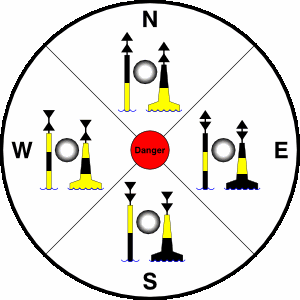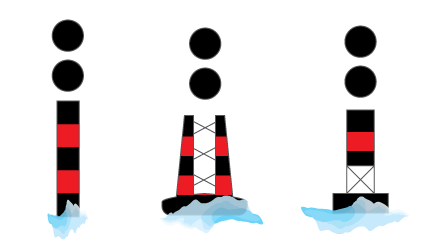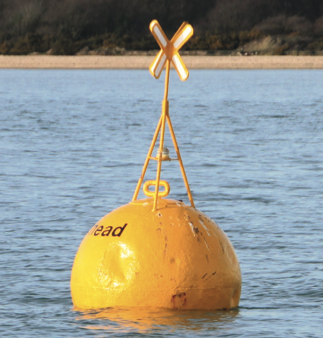A navigational aid is any sort of marker which aids the traveler in navigation, usually nautical or aviation travel. Common types of such aids include lighthouses, buoys, fog signals, and day beacons.
LATERAL MARK
A lateral buoy, lateral post or lateral mark, as defined by the International Association of Lighthouse Authorities, is a sea mark used in maritime pilotage to indicate the edge of a channel.
 SOURCE:GOOGLE IMAGE
SOURCE:GOOGLE IMAGE
A vessel heading in the direction of buoyage (e.g. into a harbour) and wishing to keep in the main channel should:
- keep port marks to its port (left) side, and
- keep starboard marks to its starboard (right) side.
The IALA defines them as Region A and Region B:
- Region A comprises Europe, Africa, and most of Asia and Oceania, as well as Greenland.
- Region B comprises the Americas (except Greenland), Japan, North and South Korea, the Philippines, Taiwan,[3] Hawaii, and Easter Island.
 SOURCE :GOOGLE IMAGE
SOURCE :GOOGLE IMAGECARDINAL MARK
 SOURCE : GOOGLE IMAGE
SOURCE : GOOGLE IMAGE
A cardinal mark is a sea mark (a buoy or other floating or fixed structure) used in maritime pilotage to indicate the position of a hazard and the direction of safe water.
Cardinal marks indicate the direction of safety as a cardinal (compass) direction (north, east, south or west) relative to the mark. This makes them meaningful regardless of the direction or position of the approaching vessel, in contrast to the (perhaps better-known) lateral mark system.
 SOURCE : GOOGLE IMAGE
SOURCE : GOOGLE IMAGE
A cardinal mark may be used to accomplish the following:
- Indicate that the deepest water is an area on the named side of the mark
- Indicate the safe side on which to pass a danger
- Draw attention to a feature in a channel, such as a bend, junction, branch, or end of a shoal
- Draw attention to a new danger such as a grounded ship. In such cases two equal marks are often placed together to indicate that it's a newly marked danger and is not yet printed in official charts.
SAFE WATER MARK
A Safe Water Mark, as defined by the International Association of Lighthouse Authorities, is a sea mark used in maritime pilotage to indicate the end of a channel. It usually implies that open, deep and safe water lies ahead, though it is sometimes also used to indicate the start and end of a buoyed section of a continuous narrow channel, or a line of these marks can be used to mark a safe route through shallow areas.[1] It is therefore important to consult an appropriate chart to determine the exact meaning in each case. The marker is also sometimes known as a Fairway Buoy.
SOURCE : GOOGLE IMAGE
It is recognisable by its red and white vertical stripes and commonly bears a top-sign in shape of a red ball. Lighted buoys either flash Morse code "A", or one long flash, occulting (more light than dark) or isophase (equal light and dark), every 10 seconds (L Fl 10s).
ISOLATED DANGER MARK
An Isolated Danger Mark, as defined by the International Association of Lighthouse Authorities, is a sea mark used in maritime pilotage to indicate a hazard to shipping such as a partially submerged rock.
It is recognisable by its black and red bands and top-mark of two black balls.
Its distinctive sequence of flashing white light consists of 2 quick flashes in intervals of either 5 or 10 seconds.

SOURCE : GOOGLE IMAGE
SPECIAL MARK
A Special Mark, as defined by the International Association of Lighthouse Authorities, is a sea mark used in maritime pilotage. It is recognisable by its yellow colour and X, (also referred to as a St. Andrews Cross or saltire) top-mark. It has a distinctive sequence of various flashes that does not match any other navigational mark flashes in its vicinity.


SOURCE: GOOGLE IMAGE
EMERGENCY WRECK BUOY
An Emergency wreck buoy is used to warn of a new wreck which has not yet been listed in maritime documents. The buoy is expected to be deployed for the first 24-72 hours after the wreck occurs. After that time more permanent buoyage
The buoy is designed to provide to "provide a clear and unambiguous mark of a new and uncharted danger. The buoy is painted with 4, 6 or 8 vertical stripes of alternate yellow and blue. In addition it may have the word "WRECK" painted on it. Optionally it may carry a vertical (St. George's) cross painted yellow. The light flashes alternate yellow and blue for one second each with a half second gap between. No other navigation mark uses blue.

SOURCE: GOOGLE IMAGE
No comments:
Post a Comment